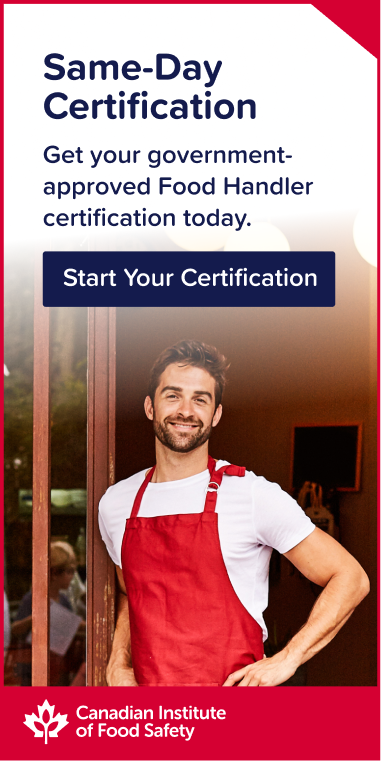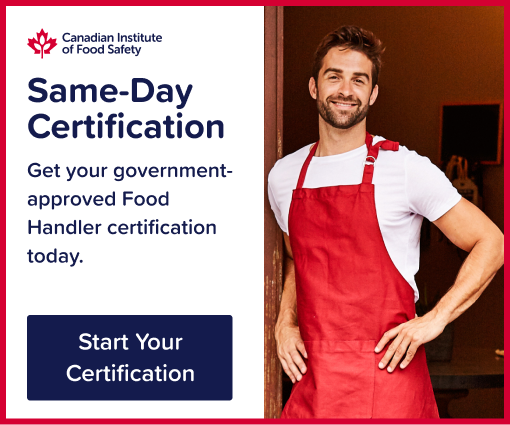.jpg?width=820&height=462&name=Depositphotos_126941234_XL%20(1).jpg)
Food Handlers play an integral role in the prevention of food-borne illnesses. With the relevant training and food safety procedures in place, they can protect the well-being of consumers to the best of their ability.
The Canadian Institute of Food Safety (CIFS) delivers an extensive curriculum as part of the Food Handler Certification Course. The topics included are designed to equip you with the knowledge and skills to meet food safety standards.
In this blog, we will discuss the key aspects of this course so that you know what to expect before enrolling with CIFS.
Why Is Food Handler training important?
Approximately four million cases of food-borne illness are reported annually in Canada, predominantly due to improper food handling. While most individuals experience only minor discomfort, some cases can be severe, leading to hospitalization or even death in extreme instances.
Food Handler training is essential: it ensures that Food Handlers can recognize common causes of food-borne illnesses and take appropriate action to prevent them.
Food Handler Certification Course curriculum
The Food Handler Certification Course is divided into four easy-to-follow units containing 11 interactive lessons.
This government-approved curriculum is designed to equip you with a comprehensive understanding of food safety that can be translated into responsible food handling practices in the workplace.
|
Module |
Key topics covered |
Purpose |
|
Module One: Understanding Food Safety |
Food contamination (biological, physical, chemical); high-risk groups; allergy incident handling |
Introduces foundational hazards and responsibilities |
|
Module Two: Preventing Food-Borne Illness |
Personal hygiene & workplace behaviour; time & temperature control; cleaning & sanitizing; maintenance of premises & equipment |
Builds core safe‐handling practices |
|
Module Three: Working With Food Safely |
Purchasing, receiving and storing; preparing food; serving & dispensing food |
Covers the full flow of safe food handling |
|
Module Four: Managing Your Food Safety Plan |
Overview of Food Safety Plans & HACCP concepts |
Provides the strategic view of system control |
|
Assessment & Certification |
Final exam (multiple-choice, pass mark 70%) within 30-day access; certificate issued upon successful completion |
Validates knowledge and grants certification |
Module One: Understanding Food Safety
During this module, you will explore the causes of food-borne illnesses and food contamination, including biological, physical, chemical and cross-contamination, before reviewing high-risk customer groups and learning the steps for handling food allergy incidents.
Lesson 1 - Understanding Food Contamination
Lesson 2 - Food-Borne Illness & Allergy Management
Lesson 3 - Food Safety Laws & Responsibilities
Module Two: Preventing Food-Borne Illness
In this module, you will learn about food safety laws, as well as techniques for preventing food-borne illnesses, including the importance of personal hygiene and workplace behaviour. You will also explore temperature zones, time control, and food thermometers. After that, there is an opportunity to review maintenance, cleaning and sanitizing procedures for food premises.
Lesson 4 - Personal Hygiene & Workplace Behaviour
Lesson 5 - Time & Temperature Control
Lesson 6 - Cleaning & Sanitizing
Lesson 7 - Maintaining Food Premises & Equipment
Module Three: Working With Food Safely
This module is all about working with food safely at each stage of the food handling process. This includes maintaining food premises and equipment, pest control and waste disposal. You will also learn how to receive, check, store and handle food safely.
Lesson 8 - Purchasing, Receiving & Storing Food Safely
Lesson 9 - Preparing Food Safely
Lesson 10 - Serving & Dispensing Food Safely
Module Four: Managing Your Food Safety Plan
The final module of the course is designed to give you a better understanding of food safety plans and HACCP principles.
Lesson 11 - Managing Your Food Safety Plan
Assessment
After completing all the lessons outlined above, you are required to pass a final exam designed to verify your knowledge.
You must pass this exam within your 30-day course access period to achieve certification. You have unlimited attempts to score at least 70 percent, answering 50 multiple-choice questions within the 60-minute time limit.
By law, the test requires proctoring. A Proctor is a person who observes you via a webcam as you complete the exam. Proctors are available 24 hours a day, 7 days a week, enabling you to participate at any time.
Certification
The CIFS Food Handler Certification is recognized in every province and territory across Canada, allowing you to work in different regions without recertifying.
The entire course is designed to be as efficient as possible so that you can quickly fulfill your food safety training obligations.
Enrolment is open to anyone and can be completed online or over the phone. Once enrolled, you will receive 24/7 access to the course for up to 30 days, allowing you to begin learning immediately or at a time and place that suits you.
The course takes just a few hours to complete, including the 1-hour exam. After finishing the exam, you can request your Food Handler Certificate immediately. Most students receive their certification documents within 60 minutes.
Take the next step to become a certified Food Handler
The CIFS Food Handler Certification Course meets the requirements of food safety legislation and is recognized all over Canada. After participating in the course, you will be equipped with the skills to understand food safety hazards, how they arise and how to prevent them from impacting consumer health.
Begin your certification journey by enrolling today, or get in touch with our team to discover all the benefits this course has to offer.






